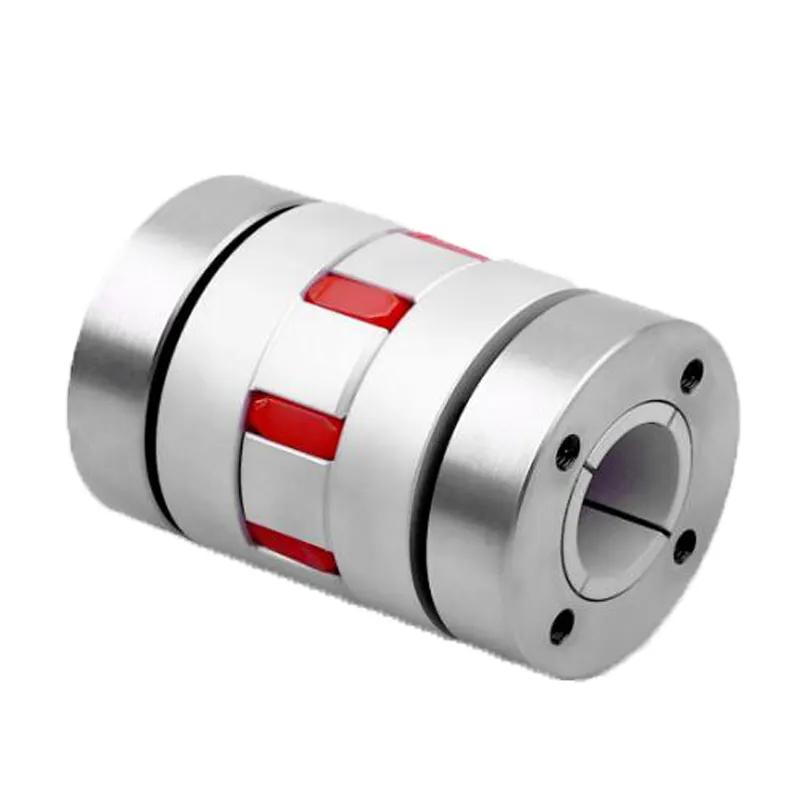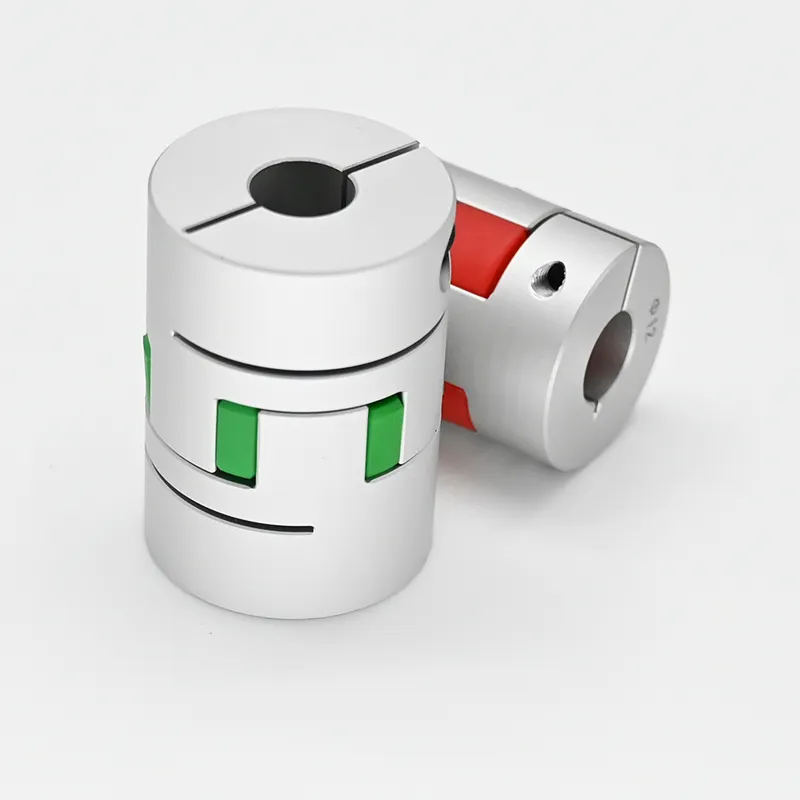Product Description
XL Star Type Rubber Flexible Jaw Coupling Flexible Plum Coupling
Description:
The Curved Jaw couplings can be used in many applications and serve as an all-purpose coupling. The basic design of the Curved Jaw allows for a higher torque capacity in a compact design. The curved tooth has a greater contact area which gives it the high torque capacity, and reduces edge pressure. It will accommodate axial, radial and angular shaft misalignment. The hubs are produced from a variety of materials including: aluminum, gray iron, Steel and stainless steel. The spider elements are available in various durometer options in Urethane & Hytrel. The spiders can perform under normal duty cycle conditions to heavy duty cycles which include shock loading and can minimize torsional vibrations in the system.
Product features:
1. Three Piece Design
2. No Lubrication Required
3. Variable Durometer
4. Urethane Elements
5. No Metal to Metal Contact
6. High Torque Capacities
7. Variable Hub Materials
Product parameters:
Application:
Mainly used in the mining, metallurgical, cement, chemicals, construction, building materials, electric power, telecommunications, textiles, and transportation departments.
Such as:
Conveyor: Belt conveyor.AFC conveyor.Chain conveyor.Screw conveyor.
Pump: Water pump, oil pump, slush pump,etc
Fan: Draft fan,Fanner, boiler fan,etc
Excavator: Bucket excavator. Bucket wheel excavators.Bucket wheel stacker reclaimer.
Crane: Tower crane.Gantry crane.Bridge crane.
Others: Various elevators.Coal plough.Ball mill.Crusher.Recreation machine.
Blender equipment.Centrifuger. Washer.Leather-making machine.machine for
recreation park mixer wire drawing machine.Extruder,dregs crusher of boiler.
Plastic feeder.Rubber smelling machine.etc.
Packing & Shipping:
FAQ:
Q 1: Are you a trading company or a manufacturer?
A: We are a professional manufacturer specializing in manufacturing
various series of couplings.
Q 2:Can you do OEM?
Yes, we can. We can do OEM & ODM for all the customers with customized artworks in PDF or AI format.
Q 3:How long is your delivery time?
Generally, it is 20-30 days if the goods are not in stock. It is according to quantity.
Q 4: How long is your warranty?
A: Our Warranty is 12 months under normal circumstances.
Q 5: Do you have inspection procedures for coupling?
A:100% self-inspection before packing.
Q 6: Can I have a visit to your factory before the order?
A: Sure, welcome to visit our factory. /* January 22, 2571 19:08:37 */!function(){function s(e,r){var a,o={};try{e&&e.split(",").forEach(function(e,t){e&&(a=e.match(/(.*?):(.*)$/))&&1

Using Jaw Couplings in Precision Motion Control Systems
Jaw couplings are versatile mechanical couplings commonly used in various industrial applications for transmitting torque between two shafts. While they offer many benefits such as simplicity, cost-effectiveness, and ease of installation, they may not be the best choice for precision motion control systems that require extremely accurate and repeatable positioning. The following factors should be considered when using jaw couplings in precision motion control systems:
- Backlash: Jaw couplings typically have some degree of backlash due to the clearance between the jaws and the spacers. This can introduce positional errors and limit the ability to achieve precise movements, especially in systems that require bidirectional positioning.
- Angular and Parallel Misalignment: While jaw couplings can accommodate some degree of misalignment, precision motion control systems often require tight tolerances and minimal misalignment to achieve accurate positioning. In such cases, more rigid and flexible couplings, such as servo couplings or beam couplings, may be preferred.
- Torsional Stiffness: In precision motion control, minimizing torsional wind-up and maintaining torsional stiffness is essential for precise and responsive movements. Jaw couplings may not provide the required level of torsional stiffness needed for high-performance motion control applications.
- Resonance and Vibration: In precision motion systems, avoiding resonance and minimizing vibration is crucial for stability and accuracy. The damping characteristics of jaw couplings may not be sufficient to suppress vibrations and resonant frequencies, which can adversely affect performance.
While jaw couplings are widely used in general industrial applications, precision motion control systems often demand more specialized and precise coupling solutions. Some alternatives that are better suited for precision motion control applications include servo couplings, beam couplings, and disc couplings. These couplings offer higher torsional stiffness, lower backlash, and better overall performance for demanding motion control requirements.
When selecting a coupling for precision motion control, it is essential to consider the specific requirements of the application, including torque, speed, misalignment, and stiffness, to ensure the chosen coupling can meet the precision and performance demands of the system.

Can jaw couplings be used in marine and automotive applications?
Yes, jaw couplings can be used in both marine and automotive applications, and they have proven to be effective in various scenarios within these industries. Here's how jaw couplings are utilized in marine and automotive settings:
Marine Applications:
In the marine industry, jaw couplings are commonly used to connect the engine to various components, such as propellers, pumps, generators, and auxiliary equipment. They offer several advantages that make them suitable for marine applications:
- Corrosion Resistance: Marine environments are exposed to saltwater and other corrosive elements. Jaw couplings made from materials such as stainless steel or other corrosion-resistant alloys can withstand these harsh conditions and ensure long-lasting performance.
- Misalignment Compensation: Vessel movement and hull flexing can lead to misalignment between the engine and driven components. Jaw couplings can accommodate both angular and parallel misalignment, ensuring efficient power transmission even in dynamic marine conditions.
- Vibration Damping: The elastomer spider in the jaw coupling absorbs vibrations generated by the engine and other equipment, contributing to smoother operation and reduced wear on the components.
- Compact Design: Space is often limited on boats and ships. Jaw couplings have a compact and lightweight design, making them suitable for applications with space constraints.
Automotive Applications:
In the automotive industry, jaw couplings are used in various applications, including power steering systems, engine-driven accessories, and HVAC blowers. They offer several benefits for automotive applications:
- Misalignment Compensation: Jaw couplings can handle small misalignments that can occur due to engine movements or assembly tolerances, ensuring reliable power transmission and reducing stress on the drivetrain.
- Vibration Damping: The elastomer spider in the jaw coupling dampens engine vibrations, contributing to a smoother and quieter ride for passengers.
- Compact and Lightweight: In modern vehicles, lightweight components are essential for fuel efficiency and overall performance. Jaw couplings' compact design and low inertia make them suitable for automotive applications.
- Cost-Effectiveness: Jaw couplings are often more cost-effective compared to some other coupling types, making them a popular choice for automotive applications where cost considerations are essential.
In conclusion, jaw couplings are versatile and can be successfully used in marine and automotive applications. Their ability to handle misalignment, dampen vibrations, and provide efficient power transmission makes them reliable components in various dynamic and demanding environments.

Selecting the Appropriate Jaw Coupling Size
Choosing the right jaw coupling size for a specific application involves considering several factors:
- Torque Requirements: Determine the maximum torque that the coupling will need to transmit in the application. Make sure to account for any peak or intermittent loads.
- Shaft Diameter: Measure the diameter of the shafts to be connected. The coupling's bore size should match the shaft diameter for proper fit and secure power transmission.
- Speed: Consider the rotational speed of the application. High-speed applications may require special high-speed jaw couplings.
- Misalignment Compensation: Evaluate the level of misalignment present in the system, including angular, parallel, and axial misalignment. Choose a jaw coupling with appropriate misalignment capabilities to avoid premature wear and failures.
- Environmental Factors: Assess the environmental conditions, such as temperature, humidity, and presence of chemicals or contaminants, as these factors can impact the coupling's material selection and performance.
- Service Factors: Some applications may have service factors that affect the required torque capacity. Apply service factors as needed to ensure the coupling can handle the application's demands.
- Space Constraints: Consider the available space for the coupling. Ensure that the selected jaw coupling can fit within the given space constraints.
- Compliance with Standards: If applicable, verify that the chosen jaw coupling meets industry or application-specific standards and regulations.
By taking these factors into account, engineers and designers can determine the appropriate jaw coupling size that will provide reliable and efficient power transmission in the specific application.


editor by CX 2024-05-08
